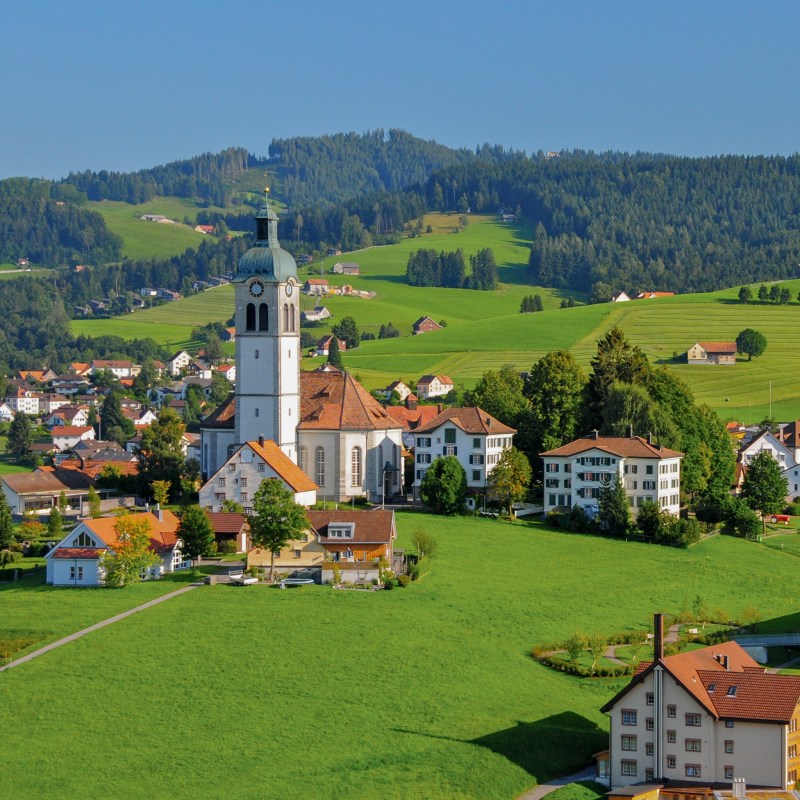
The magic word is Appenzell. This small, car-free village sits at the center of Switzerland’s smallest canton: Appenzell. In fact, it’s a double canton: Catholic Appenzell Innerrhoden and Protestant Appenzell Ausserrhoden. Nowhere else in Switzerland is the transition from hilly mittelland to the rocky, towering alpine world more striking than here. You have rolling hills covered with green meadows populated by fat cows that give the milk for the famous Appenzeller Cheese and seemingly out of nowhere, soaring, snow-covered mountains up to nearly 10,000 feet. A paradise in summer and winter, Appenzell itself fascinates because it so closely reflects what you might perceive as the essence of the most traditional Switzerland: cheese, cows, cowbell, colorful houses, and beautiful costumes closely connected with centuries-old traditions that the locals stick to this day. For an overview of this very special Swiss region’s history and culture, visit the Museum Appenzell in the Town Hall.
Videos by TravelAwaits
The Middle Ages have left their mark on Appenzell, and you find this part of Swiss history in many details as you walk along, which is one of the greatest pleasures in the village. Appenzell fought its fair share of wars of independence during the Middle Ages, and you’ll see monuments and other reminders, like the Memorial of The Battle of Stoss Pass in 1405.
Other things to do while in Appenzell include listening to dulcimer music, learning all about yodeling, and watching how traditional leather goods inlaid with metal ornaments are made.
The nearest airport is Altenrhein/St, Gallen but it’s not an international airport. Better and far bigger are Zurich, which is only 40 miles away, or Basel. Both run frequent buses and trains to Appenzell.
1. Listen To The Haunting Music
The atmosphere in Appenzell reflects a certain melancholy which other Swiss sometimes attribute to the culture clinging too much to the past and traditions. The mood also enters into the Appenzellstoeckli or folk music. Yodeling is the centuries-old form of communication between shepherds and farmers across deep valleys. Zauerli and Ruggusseli are the two forms you can hear in Appenzell to this day. The music, also rather haunting, is mostly performed by violins, dulcimer, cello, and contrabass. However, a certain sadness does not mean that the Appenzellers don’t like a good and rather raucous dance.
It’s a treat to visit the workshop of Johannes Fuchs, one of just a handful of dulcimer and Hackbrett players and builders.

2. Dance With The Locals
For the full Appenzell experience, it’s best to stay in the village. Luckily, there are two picturesque hotels, which have extraordinary locations, a lot of history, and are the venue for local dances. The first is the Hotel Hof Weissbach. This four-star hotel, just steps away from Appenzell railway station, offers many comforts, including an indoor pool, sauna, and health center as well as its own therme. A romantic, lantern-lit footpath leads through the woods next door to the hotel. But the highlight, as far as local culture is concerned, happens on Wednesday evenings when they arrange an Appenzell Evening with folk music and dancing, happily joined by the locals. You’ll also have a chance to enjoy local specialties — don’t forget the famous cheese, red wine, or strong beer from the local brewery.
The other accommodation is Berggasthaus Aescher. Berggasthaus translates into mountain inn, and that’s what you find here. Hewn into the cliff, the inn can only be reached by gondola followed by a short but rather steep hike. It’s also built around caves where early 17th-century hermits lived, sometimes next to wild bears. The food in the Aescher is legendary, but they also have folk music evenings where you can, again, dance with the locals and listen to the unique music of Appenzell.

3. Buy Unique Leather Goods
The emphasis in Appenzell is on tradition, art, and crafts. You should visit Hampi Faessler’s Atelier to admire a first-rate artist. He makes, among many other things, extraordinary, traditional leather belts, delicately inlaid with metal cut-outs of cows and even farmers. Beautiful, painted pieces of furniture are also to be found as well as many other decorative items that will be the envy of your friends when you bring them back home. They also make splendid gifts.
4. Learn All About Cheese
Appenzeller cheese has always had a great reputation, even in Switzerland itself. Not only is there the strongest Swiss cheese, but there are also many secret recipes, which are meticulously adhered to by the dairy farmers in Stein. It’s best to go on a guided tour, where some, if not all, secrets will be revealed. You can taste different kinds, from fresh and low-fat to mature and full-fat, and even make your own over a copper pot. The matured end product will be sent to you.
While there, swing by the butcher next door and try the local Mostbroeckli, cured beef, and at the bakery, indulge your sweet tooth with Appenzeller Biberli, soft gingerbread filled with almond paste. In one trip, you will have sampled some of Appenzell’s most famous specialties.

5. Stroll By The Painted Houses
Appenzell is a very small place, so it doesn’t take long to walk along the main street and admire the great variety of painted facades. Like everything in Appenzell, this is a tradition that started many years ago with one house, the Kreuz. Then, the owner of the Raben got jealous and adorned his house, and so the competition went until you see the colorful place the town center is today. Whilst you are walking along, visit the Appenzell Art Museum to see some local and contemporary art.

6. Spend New Year’s With The Mummers
If your schedule allows, try to be in Appenzell for New Year’s to witness a bizarre spectacle you will find nowhere else in the world. In the neighboring village of Umasch, diary farmers assemble, fully masked and disguised with costumes made from natural materials like rags, twigs, roots, leaves, and grass. Wordlessly they wander through the snow from one stop to the next, occasionally yodeling and shaking cowbells. The entire event is known as Sylvesterchlausen and is said to date back to pagan times.
7. Ride The Appenzell Railway
It’s a great pleasure to explore the beautiful Appenzell landscape by riding in the fire engine red open Appenzell Railway. The little train runs every half hour; no reservation is needed. A great round trip is from St. Gallen to Appenzell. St. Gallen is much bigger than Appenzell, but you might want to stop and at least look at the world-famous abbey, a UNESCO World Heritage site.

8. Watch The Cows Come Home In September
If you can make it to Appenzell in September, you can literally watch the cows come home. It’s the time of the ceremonial descent of cattle from the mountain pastures to their homes in the valley in preparation for the winter. It’s a colorful spectacle because the milk cows are adorned with flower garlands and huge bells, children in pretty costumes walk in front, the well-trained cattle dogs run by the side, and a wooden wagon carries all the equipment needed to make butter and cheese in the mountains.
9. Walk The Barefoot Trail
Appenzell is a hiker’s paradise and dotted with many hiking trails, none of which is very difficult to manage. An experience of a special kind is to walk the Barefoot Trail, which leads from Jakobsbad to Gontenbad literally without shoes and socks. The sensation of walking over grass and through small streams is invigorating. At the halfway point in Toobeshopf, you can bathe your arms following the methods of Dr. Kneipp, and at the endpoint, Gontenbad, you can do the same with your tired feet.
Pro Tip
When visiting Appenzell, don’t expect utter luxury. This is a trip that focuses on culture, tradition, and nature. Be aware that the locals, although friendly, are reserved people who are proud of their heritage and traditions. Respect that. But they might thaw after a few glasses of pflumli or kirsch, both potent schnapps.
Related articles:
